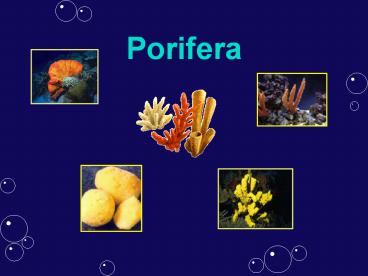Porifera PowerPoint PPT Presentation
1 / 42
Title: Porifera
1
Porifera
2
Phylum Porifera the sponges
- Porus (pore) Fera (bearing) Abundant marine
group with some fresh water species. Can range in
size from a few mm high to 1-2 meters.
3
Classification Kingdom Animalia
(animals) Phylum Porifera (sponges) Classes 1.
Calcarea (calcium carbonate )- having spicules,
only class with asconoid and synconoid canals 2.
Demosponginae (horn sponges, like the bath
sponge) 90 of all sponges 3. Scleropongiae
(coralline or tropical reef sponges) 4.
Hexactinellida (glass sponges). Mostly deep, cold
water
4
Common Examples
- Glassy Sponge
5
Common Examples
- Glassy Sponge
- Encrusting Sponge
6
Common Examples
- Glassy Sponge
- Encrusting Sponge
- Finger Sponge
7
Common Examples
- Glassy Sponge
- Encrusting Sponge
- Finger Sponge
- Tube Sponge
8
Common Examples
- Glassy Sponge
- Encrusting Sponge
- Finger Sponge
- Tube Sponge
- Orange Sponge
9
Characteristics
- Porifera are asymmetrical
- No organs, mouth, digestive system or nervous
tissue. - Their bodies are porous, with canals and chambers
thru which a water current flows, - One or more internal cavities lined with
choanocytes.
10
- Simplest Multicellular Organism
- Classified by their skeleton
- Pump 22.5 liters (on average) of water a day
through its body
11
- No mouth organs, systems, digestive tract, anus,
nerve cells. - Surface perforated by numerous pores. These outer
pores are called the pinacocytes - Incurrent openings are small and numerous (called
ostia) - Excurrent - few and large
12
- Internal cavities.
- Interior is hollow (called the spongocoel) or can
be permeated by numerous channels. - Some or all interior spaces are lined by
specialized cells called choanocytes. These cells
beat and pull water through the ostia. - -The mesohyl lies between the inner and outer
cell layers. It contains a jelly like fluid
called the mesoglea.
13
Sponge Anatomy 101
14
How do sponges eat?
- Sponges are suspension feeders.
- Water brings in food that is trapped by the
choanocytes and transferred to the rest of the
sponge by cells called archaeocytes.
15
How do sponges eat?
choanocytes
amebocytes
16
(No Transcript)
17
Sponge Organization
- The body is supported by an endoskeleton of
spongin (a form of collagen) and/or tiny spicules
(made of calcium or silica).
18
Spicules
- calcium carbonate
- microscopic
- geometric
- all over sponges body
- fingerprint of sponge
19
Canal Systems
- Three major types
- Asconoid-the simplest type of organization. Small
and tube shaped, water enters the sponge through
dermal pores and flows into the interior.
20
Asconoid
21
Canal Systems
- Syconoid-larger versions of asconoids, still
having just a single osculum. However, the body
wall is generally thicker and more complex with
incurrent canals rather than simple pores.
22
Syconoid
23
Canal Systems
- Leuconoid-the most complex in design in that not
all the chambers are flagellated. - Water flowing in through incurrent canals is
pumped through the chambers and expelled via one
of a series of oscula. - Best adapted to increase size.
24
Leuconoid
25
Sponge Reproduction
26
Cool Stuff Regeneration!
- Tremendous ability to repair and restore lost
parts. - Sponge tissue has some similarity to human
connective tissue. Could lead to aid in tissue
transplantation. - Asexual Reproduction
- Asexual budding can produce new sponges.
- Sexual Reproduction
- Most sponges are hermaphroditic and can
internally fertilize themselves.
27
Importance of Sponges
- Reefs provide habitat for many animals
- Vacuums of the sea -- clean up the sea
floor/oceans - Sponges are a commercial venture
- Several medicinal compounds, including
antibiotics, antivirual drugs, and drugs for
leukemia come from sponges.
28
(No Transcript)
29
(No Transcript)
30
(No Transcript)
31
(No Transcript)
32
(No Transcript)
33
(No Transcript)
34
Rope Sponges
35
(No Transcript)
36
(No Transcript)
37
(No Transcript)
38
Question 1
- Which of the following characteristics makes
sponges unique among other animals? - They are multicellular.
- They are heterotrophic.
- They do not have a mouth or gut.
- They are capable of reproducing sexually.
39
Question 2
- What type of cellular structure does a
choanocyte use to help create the current inside
a sponge? - cilium
- flagellum
- spongellium
- pseudopodium
40
Question 3
- The skeleton of a sponge includes tiny
crystal-like structures that are called - spongin
- spicules
- collagen
- choanocytes
41
Question 4
- Which of the following sponge body types would
you expect to find in this sponge from the video? - Asconoid
- Syconoid
- Leuconoid
42
Question 5
- Which of the four classes of sponges includes
sponges with both silica and calcium carbonate in
their skeletons? - Calcarea
- Hexactinellida
- Demospongiae
- Sclerospongiae

